What is Chaturanga Dandasana / Four Limbed Staff Pose?
The name comes from the Sanskrit ‘catur’ meaning “four” and anga meaning “limb” , danda meaning “staff”; and asana, “posture” or “seat”. Chaturanga Dandasana or Four-Limbed Staff pose also known as Low Plank, is an asana in yoga and in some forms of Surya Namaskar (Salute to the Sun), in which a straight body parallel to the ground is supported by the toes and palms, with elbows at a right angle along the body.
From Sanskrit to English:
Sanskrit pronunciation: Chaturanga Dandasana (chaht-tour-ANG-ah dan-DAHS-anna)
Meaning: chatur = four; anga = limb; danda = staff. Known in English as Four-Limbed Staff or Lower Plank Pose, it originates as a way to come into prostraction or bowing to the life force. Just like any other fundamental asana (pose) belonging to Surya Namaskar (Sun Salutation), it is an embodied act of prayer and meditation – a reverence to the sun. The mantra associated with it is om pushne namah which translates to, “salutations to the giver of nourishment and strength.”
Benefits of the Chaturanga Dandasana pose
Here are some of the benefits of practicing this pose:
+ Strengthens leg muscles, abdomens, shoulders, arms and wrists
+ Develops core stability
+ Tones the organs in the abdominal cavity
+ Stimulates the manipura chakra (self-esteem center)
+ Prepares the body for arm balances, inversions and backbends
Yoga for every BODY
Chaturanga Dandasana is often referred to and breezed-through, but it’s rarely taught in depth. In most yoga classes, it has become a transition pose rather than an asana in its own right. And the chances of repeatedly misaligning the body in this pose and getting injured (as a result of this) are high – especially in Ashtanga Yoga, given the numerous sun salutations and vinyasas present in the practice.
Yoga is for everyone yet this doesn’t mean every pose is. Chaturanga Dandasana is particularly demanding; it requires a lot of physical strength. And while some of us may be gifted, the rest of us will have to work with patience and determination to build the necessary strength. Instructions for the standard version of Chaturanga Dandasana are provided below. That said, please keep scrolling for variations of the pose as these will enable you to experience a safe alignment and build muscle memory, while giving your body the time it needs to grow stronger.
For more details on Yoga Teacher Training, click here.
Standard Chaturanga Dandasana
1. In Ashtanga Yoga we start from Adho Mukha Svanasana. Keeping the toes tucked, come into a high plank with the arms straight, so that the shoulders are in line with the elbows and wrists. Engage the core and draw the navel towards the spine. Let the head fall naturally.
2. Lower the body, parallel to the ground. Keep pressing into the toes. The legs are extended and engaged, the knees slightly above the floor. Careful: there’s a tendency to drop the upper back while poking up the tailbone towards the ceiling. Instead, we want to use the root lock, engage the core, and draw the pubis towards the navel to keep the tailbone and hips firmly in place. Also, don’t let the elbows splay out to the sides; hold them close to the upper body and send them towards the heels. The upper arms should be parallel to the floor. The space between the shoulder blades is broad. The shoulders are right above the wrists, far from the ears.
3. Press the bases of the index fingers firmly into the floor. Lift the top of the sternum and look forward.
Modification 1: Keeping the hips up
As previously mentioned, since the pelvis tends to drop in this pose, the sternum also often collapses, putting the shoulders at risk. Supporting the body weight is a great way to get a feel for the pose without demanding excessive strength or compromising a body part. Using a bolster beneath the chest and hips can support your body weight and allow for you to lift your sternum and protract your shoulder blades (see picture A for instructions). A slightly more challenging version of this would be to place a soft block beneath your sternum. In this case, more engagement from your legs and core will be required (see picture B for instructions). If you have no props available, you can also use the support of your knees. This way, you won’t need to engage the hamstrings and calves, the hips will stay up and in place, making it a lot easier to balance the upper body (see picture C for instructions).
A
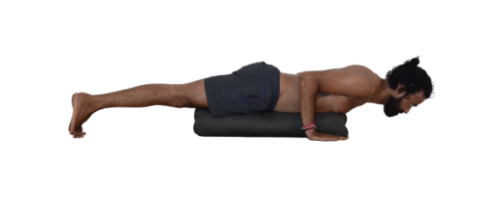
1. Place a bolster parallel to the long sides of the mat and lay on it.
2. Your elbows and wrists should form a 90 degree angle.
3. Tuck your toes and engage your legs
4. Push into your hands, broaden your shoulders, send them away from the ears and shift your gaze slightly forward.
B
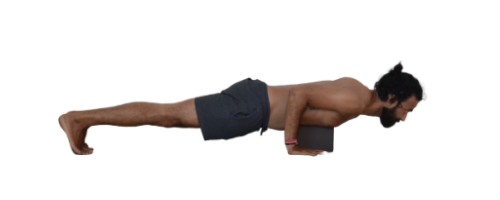
1. Come onto all fours and place a soft block beneath your chest (you can try placing the block at different heights to determine what works best for you). Make sure your hips are directly above your knees and that your shoulders are directly above your wrists.
2. Come forward with your torso, bending your elbows at a 90 degree angle. Place your sternum over the soft block.
3. Straighten your legs, keeping your toes tucked.
4. Roll your shoulders back, broadening them and look slightly ahead of you.
C
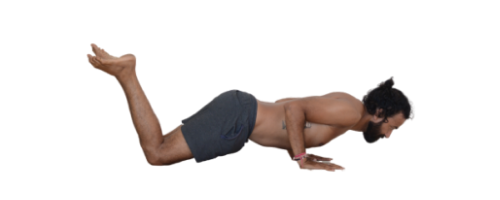
1. Come onto all fours.
2. Come forward with your torso, bending your elbows at a 90 degree angle.
3. Send your feet to the sky or keep them on the mat and focus on the alignment in the upper part of your body.
Modification 2: Assisting the elbows & upper arms
The elbows & upper arms should be another major concern for us when practising Chaturanga Dandasana. To help us protract the shoulder blades and keep the sternum up, the elbows tend to splay out to the sides of the triceps muscles are weak and unable to support the upper body weight. This will inevitably lead the upper back to collapse, putting the shoulders at risk once again. You can remove a bit of body weight by placing a soft block beneath your thighs.
You can also use a strap to keep your elbows in place. That will allow you to use your triceps, instead of your pectoralis muscles, in order to keep your upper body up or prevent your torso from lowering too close to the ground. This, in addition to the use of blocks beneath the shoulders, should provide great assistance (See picture D for instructions). Once you get familiar with this modification, you can try removing the soft block and strap, using the blocks beneath the shoulders only (See picture E). If looking forward causes you to feel a strain in your neck, place a block beneath your forehead (See picture F).
D
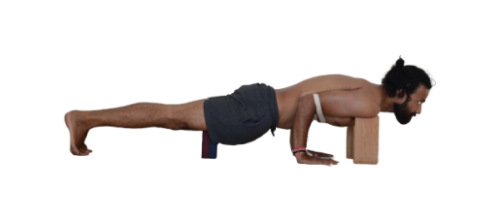
1. Place two blocks where you expect your shoulders to fall. You may have to play a little with the distance and height based on your proportions.
2. Loop a strap and slide into it with both arms so that it’s right above the elbows. You want it to be large enough so that when you bend your elbows for Chaturanga Dandasana, they will touch the sides of your torso and form a 90-degree angle. You may need to try it out a few times.
3. Place a soft block parallel to the short side of your mat, right above the knees.
4. Follow the instructions to get into Chaturanga Dandasana.
E
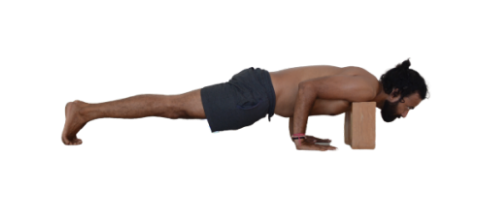
1. Place two blocks where you expect your shoulders to fall. You may have to play a little with the distance and height based on your proportions.
2. Follow the instructions to get into Chaturanga Dandasana.
F
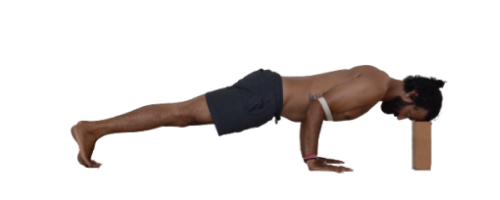
1. Loop a strap and slide into it with both arms so that it’s right above the elbows. You want it to be large enough so that when you bend your elbows for Chaturanga Dandasana, they will touch the sides of your torso and form a 90-degree angle. You may need to try it out a few times.
2. Place a block on the higher side so that it can welcome your forehead.
3. Follow the instructions to get into Chaturanga Dandasana.
Interested in becoming a yoga teacher?
Newsletter
Upcoming events and latest blogs